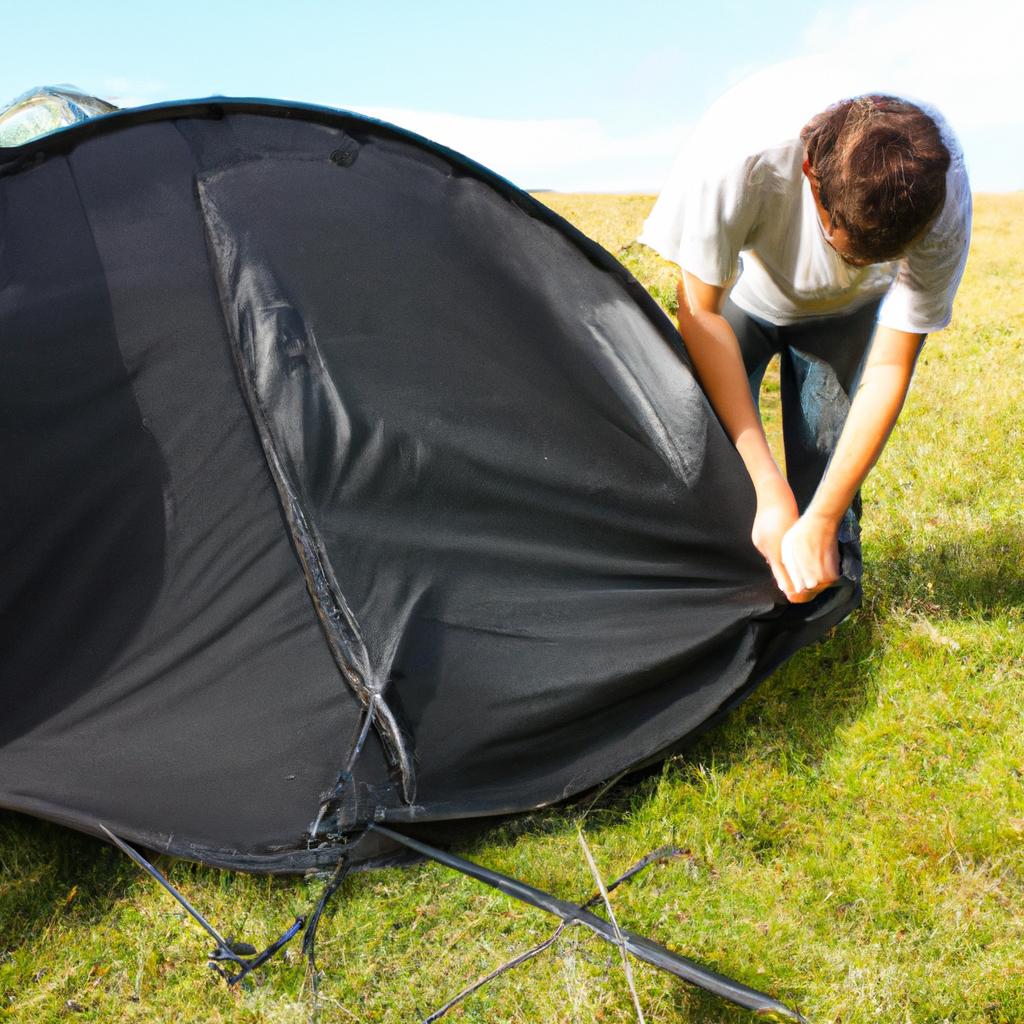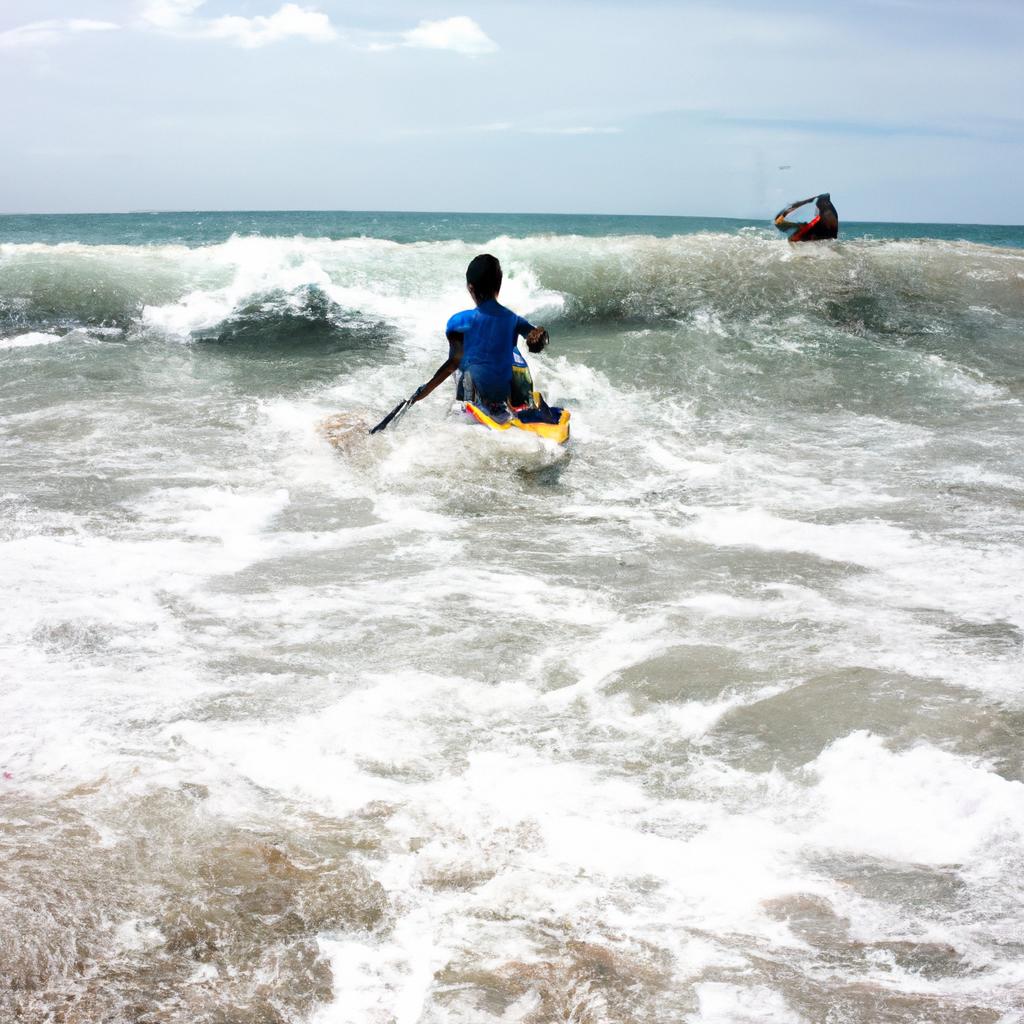In recent years, the concept of eco-tourism has gained significant attention as a sustainable approach to travel and recreation. With an increasing awareness of environmental issues and a growing desire for responsible tourism practices, eco-tourism offers a promising solution that allows individuals to explore new destinations while minimizing their impact on the natural environment. For example, in the Galapagos Islands, a renowned UNESCO World Heritage site known for its unique biodiversity, eco-tourism initiatives have been implemented to protect delicate ecosystems and promote sustainable development. This article aims to delve into the principles and benefits of eco-tourism, exploring its potential to transform the way we engage with our surroundings during recreational activities.
Sustainable travel is at the core of eco-tourism, emphasizing the importance of conserving natural resources and preserving cultural heritage. Unlike conventional mass tourism which often leads to detrimental effects such as habitat destruction or pollution, eco-tourism strives for long-term sustainability by promoting responsible practices among tourists and local communities alike. By actively involving stakeholders in decision-making processes regarding land use planning, resource management, and community involvement, this approach seeks to create positive social, economic, and environmental impacts. Moreover, through educational programs and intercultural exchange opportunities provided by eco-tourism organizations , travelers are able to gain a deeper understanding of the local culture and environment, fostering a sense of appreciation and respect.
One of the key principles of eco-tourism is minimizing environmental impact. This includes reducing carbon emissions through sustainable transportation options, conserving water and energy resources, and practicing proper waste management techniques. Eco-tourism organizations often work closely with local communities to implement these measures and ensure that natural habitats are not compromised by tourism activities.
Additionally, eco-tourism aims to support the local economy and empower communities. By promoting locally-owned accommodations, restaurants, and tour operators, eco-tourism creates economic opportunities for residents in the area. This helps to alleviate poverty and reduce dependence on external sources of income while preserving traditional livelihoods and cultural practices.
Another important aspect of eco-tourism is conservation education. Through guided tours, workshops, and interpretive signage at tourist sites, visitors are educated about the significance of protecting fragile ecosystems and biodiversity hotspots. This knowledge empowers individuals to make informed choices during their travels and encourages them to become advocates for environmental preservation even after they leave.
Ultimately, eco-tourism offers a holistic approach to travel that benefits both tourists and the destinations they visit. It allows individuals to experience unique landscapes and cultures while ensuring that these treasures are protected for future generations. As more people become aware of the importance of sustainable travel practices, eco-tourism has the potential to transform the tourism industry into a force for positive change.
Exploring Biodiversity: A Guide to Wildlife Encounters
Imagine yourself standing on the edge of a dense tropical rainforest, surrounded by the symphony of exotic bird calls and the rustling of leaves. Suddenly, you spot a flash of vibrant colors darting through the foliage – it’s a resplendent quetzal, one of Central America’s most iconic bird species. This thrilling encounter exemplifies the wonders that await eco-tourists who seek to explore biodiversity in its natural habitat.
To fully appreciate and understand wildlife encounters during eco-tourism journeys, it is crucial to approach these experiences with respect for nature and an understanding of conservation principles. First and foremost, maintaining a safe distance from animals is imperative for their well-being as well as personal safety. By observing them from afar or using binoculars, we minimize stress on the animals and reduce disturbance to their habitats.
Moreover, responsible eco-tourism practices go beyond passive observation; they entail actively contributing to local conservation efforts. Engaging with local communities can provide valuable insights into traditional ecological knowledge while supporting community-led initiatives for sustainable development. In addition, participating in citizen science projects allows visitors to contribute directly to scientific research and monitoring programs aimed at protecting vulnerable species.
Engrossed in our pursuit of biodiversity exploration, it is essential not only to marvel at the beauty but also recognize the threats faced by countless species worldwide. Consider this stark reality:
- Over 25% of mammal species are currently threatened with extinction.
- Around 40% of amphibian species face population declines.
- The world has lost approximately half of its coral reefs within the past four decades.
- Illegal wildlife trade annually generates billions of dollars in revenue.
These sobering statistics remind us why responsible tourism practices are vital for safeguarding Earth’s magnificent creatures and ecosystems. By choosing ecologically-conscious tour operators and destinations committed to minimizing environmental impact, travelers play an active role in preserving biodiversity for future generations.
By following these tips and techniques, you’ll be able to immortalize your wildlife encounters in breathtaking images that tell compelling stories without disturbing their natural habitats or behaviors. So grab your camera and let’s embark on a journey of visual storytelling amidst nature’s wonders.
Capturing Nature’s Beauty: Tips for Stunning Outdoor Photos
Having gained a deeper understanding of wildlife encounters, let us now delve into the world of eco-tourism and how it promotes sustainable travel in recreation. By embracing responsible practices, travelers can explore biodiversity while minimizing their impact on fragile ecosystems. To illustrate this concept, consider the case study of a group of nature enthusiasts who embarked on an eco-tour to the Amazon rainforest.
Eco-Tourism: Promoting Sustainable Travel
-
Environmental Conservation:
- Visitors are educated about local flora and fauna, fostering appreciation for biodiversity.
- Tour operators follow strict guidelines to minimize disturbance to natural habitats.
- Efforts are made to support conservation projects that protect endangered species.
- Local communities are involved in decision-making processes regarding tourism activities.
-
Socio-cultural Impact:
- Eco-tourism encourages interactions with indigenous communities, promoting cultural exchange.
- Local residents benefit from economic opportunities generated by sustainable tourism.
- Traditional knowledge is valued and shared, preserving cultural heritage.
- Communities have increased motivation to preserve their environment due to its economic value.
-
Economic Benefits:
- Revenue from eco-tourism contributes to local economies, supporting infrastructure development and job creation.
- Diversification of income sources reduces dependence on environmentally harmful industries like logging or mining.
- Preservation of natural resources ensures long-term financial sustainability for both locals and tour operators.
- Increased demand for sustainable products drives the growth of green businesses.
Table: Positive Impacts of Eco-Tourism
| Environmental Conservation | Socio-cultural Impact | Economic Benefits |
|---|---|---|
| Protects biodiversity | Promotes cultural exchange | Supports local economies |
| Minimizes habitat disruption | Preserves traditional knowledge | Stimulates job creation |
| Funds conservation projects | Enhances cultural heritage | Reduces dependence on harmful industries |
| Involves local communities | Motivates environmental preservation | Encourages green businesses |
In summary, eco-tourism offers a sustainable approach to travel that balances the exploration of biodiversity with responsible practices. By engaging in eco-friendly activities and supporting local communities, travelers can make a positive impact on both the environment and society. As we move forward, let us now turn our attention to another exciting aspect of eco-tourism: Paddling Adventures – Discovering Scenic Waterways.
Paddling Adventures: Discovering Scenic Waterways
Having captured nature’s beauty through stunning outdoor photos, let us now delve into an adventurous activity that allows travelers to immerse themselves in nature at its most pristine—hiking. Imagine trekking along a secluded trail surrounded by towering trees and vibrant flora, with every step revealing hidden gems waiting to be discovered.
Hiking offers an opportunity for eco-tourists to engage with their natural surroundings while promoting sustainability and conservation efforts. One example of such a hiking experience is found in the lush forests of Mount Rainier National Park in Washington State, USA. This picturesque park boasts numerous trails that lead intrepid explorers to breathtaking vistas and cascading waterfalls. The Wonderland Trail stands as an epitome of this untamed wilderness, challenging hikers with its 93-mile circuit around the iconic peak of Mount Rainier.
To fully embrace sustainable travel during your hiking adventures, here are some key considerations:
- Pack light but responsibly: Bring reusable containers for snacks and drinks, eliminating single-use plastic waste.
- Stay on designated paths: Help preserve delicate ecosystems by avoiding trampling on fragile vegetation or disturbing wildlife habitats.
- Leave no trace behind: Carry out any trash or litter you encounter and dispose of it properly upon reaching designated disposal areas.
- Support local communities: Consider staying at locally owned accommodations and purchasing souvenirs from nearby businesses, contributing directly to the economic growth of these regions.
Table – Benefits of Sustainable Hiking:
| Benefit | Description |
|---|---|
| Preservation of biodiversity | By respecting natural environments, we ensure diverse species thrive |
| Reduction of carbon footprint | Non-motorized activities like hiking minimize greenhouse gas emissions |
| Cultural exchange | Interacting with local communities fosters mutual understanding |
| Personal well-being | Immersion in nature has proven benefits for mental and physical health |
By embracing these principles, eco-tourists can make a positive impact on the environment while simultaneously enriching their own travel experiences. Exploring hiking trails off the beaten path not only offers an opportunity to connect with nature but also promotes sustainable practices that contribute to the preservation of our planet’s natural wonders.
As we continue our journey through eco-tourism activities, let us now turn our attention towards a Thrilling adventure in the treetops – zip-lining.
Flying through the Trees: The Thrill of Zip-lining
In the realm of eco-tourism, there are endless possibilities for exploring our natural surroundings. After navigating scenic waterways on a paddle adventure, another exhilarating option is to take to the skies in a hot air balloon or embark on an aerial tour. Imagine floating gently above picturesque landscapes, witnessing breathtaking views that can only be seen from above.
One captivating example is the Napa Valley Hot Air Balloon Ride in California. As dawn breaks over the vineyards, passengers ascend into the sky, greeted by golden hues stretching as far as the eye can see. The tranquility of this experience allows individuals to truly appreciate nature’s beauty while leaving minimal impact on the environment.
When considering balloon rides and aerial tours as part of sustainable travel practices, here are some key points to keep in mind:
- Reduction of carbon emissions: Compared to other forms of transportation such as airplanes or helicopters, hot air balloons have significantly lower carbon footprints due to their reliance on wind currents.
- Preservation of wildlife habitats: By observing landscapes from above without disturbing terrestrial ecosystems, these activities allow us to admire wildlife habitats without causing disruption or distress.
- Promotion of local economies: Supporting local businesses offering hot air balloon rides and aerial tours contributes directly to the economic growth of nearby communities.
- Educational opportunities: These experiences often provide knowledgeable guides who share insights about the region’s geography, flora, fauna, and cultural history.
To further illustrate the importance of responsible tourism choices, consider Table 1 below which highlights both positive impacts and challenges associated with ballooning adventures:
| Positive Impacts | Challenges |
|---|---|
| Stunning panoramic | Weather conditions |
| views | Limited capacity |
| Minimal environmental | Noise pollution |
| impact | Wildlife disturbance |
Table 1: Positive Impacts and Challenges Associated with Ballooning Adventures
In summary, eco-tourism enthusiasts can embrace the wonders of sustainable travel by considering balloon rides and aerial tours. These captivating experiences not only offer a unique perspective on our surroundings but also contribute to environmental conservation efforts. By minimizing carbon emissions, preserving wildlife habitats, supporting local economies, and providing educational opportunities, these activities exemplify responsible tourism practices.
Transitioning seamlessly into the subsequent section about “Hidden Gems: Unforgettable Wildlife Spots,” we delve deeper into nature’s realm.
Hidden Gems: Unforgettable Wildlife Spots
Embarking on a journey beneath the ocean’s surface, we encounter an enchanting realm teeming with vibrant marine life. From snorkeling to scuba diving, these water-based activities offer unparalleled opportunities for eco-tourists to engage with and appreciate the wonders of underwater ecosystems. By immersing themselves in this aquatic environment, travelers can gain a deeper understanding of the delicate balance that exists within our oceans.
Paragraph 1:
Imagine yourself floating weightlessly over coral reefs, surrounded by schools of colorful fish darting through crystal-clear waters. One popular destination for snorkelers and divers is Australia’s Great Barrier Reef. This natural wonder stretches over 2,300 kilometers along the northeastern coast and supports an array of diverse marine species. For instance, the clownfish (Amphiprioninae) finds refuge among the stinging tentacles of sea anemones while humpback whales (Megaptera novaeangliae) migrate here annually to give birth to their young. The ability to witness such ecological interactions up close underscores the importance of preserving these fragile habitats.
Paragraph 2:
To fully grasp why protecting marine environments is crucial, consider some key factors that make them unique and vulnerable:
- Fragile Ecosystems: Coral reefs are highly sensitive to changes in temperature and water quality, making them susceptible to bleaching events caused by climate change.
- Overfishing Threats: Unsustainable fishing practices deplete fish populations faster than they can reproduce, disrupting food chains and damaging entire ecosystems.
- Pollution Impact: Runoff containing chemicals from land-based sources can contaminate coastal waters, harming both wildlife and humans who rely on these resources.
- Habitat Destruction: Activities such as dredging or bottom trawling destroy essential seafloor structures where many species seek shelter and find nourishment.
Paragraph 3:
By promoting responsible snorkeling and scuba diving practices, eco-tourists can actively contribute to the preservation of marine ecosystems. Adopting sustainable approaches such as reef-friendly sunscreen usage and respecting wildlife habitats ensures that these activities remain enjoyable for generations to come. Moreover, supporting organizations dedicated to ocean conservation through donations or volunteering can have a significant impact on safeguarding our marine wonders. As we dive deeper into exploring the natural world, let us now turn our attention to mastering the art of capturing its beauty through nature photography techniques.
With each flicker of movement beneath the waves, there exists an opportunity to capture moments frozen in time. Transitioning from active participation in underwater exploration to documenting it visually, aspiring photographers can unlock new dimensions of appreciation for nature’s finest details.
Mastering the Art of Nature Photography: Essential Techniques
Transitioning from the previous section, where we explored hidden wildlife spots, let us now delve into the art of photography in nature. Imagine yourself standing amidst a lush forest, with rays of sunlight filtering through the canopy and illuminating vibrant flowers blooming on the forest floor. As you witness this captivating scenery, you raise your camera to capture this momentous beauty forever.
Photography plays an integral role in eco-tourism as it allows travelers to encapsulate their experiences and share them with others. To ensure optimal results when photographing nature, consider the following tips:
-
Composition:
- Use the rule of thirds to create visually appealing images.
- Experiment with different angles and perspectives to add depth and interest.
- Incorporate leading lines or natural frames within your composition.
-
Lighting:
- Utilize soft lighting during golden hour (the hour after sunrise or before sunset) for warm and diffused tones.
- Avoid harsh midday sun by seeking shaded areas or using reflectors/diffusers.
- Capture unique lighting conditions such as foggy mornings or dramatic storm clouds.
-
Wildlife Interaction:
- Respect animals’ space and observe without disturbing their natural behavior.
- Use telephoto lenses to maintain distance while capturing detailed shots.
- Patience is key; wait quietly for that perfect moment when wildlife reveals itself.
-
Post-Processing:
| Enhancements | Techniques |
|---|---|
| Sharpening | Adjust sharpness levels selectively |
| Color correction | Balance hues naturally |
| Noise reduction | Reduce digital noise effectively |
Incorporate these techniques thoughtfully during post-processing to enhance but not alter the authenticity of your photographs.
By developing your skills in Nature Photography, you can showcase the wonders of eco-tourism to a broader audience while also creating lasting memories for yourself. The ability to capture these moments allows us to relive them, evoke emotions, and inspire others to appreciate and protect the natural world.
Transitioning smoothly into the next section about “Navigating Nature’s Waterways: The Joys of Canoeing,” imagine capturing a serene sunset reflected in calm waters as you glide through nature’s untouched beauty from your canoe.
Navigating Nature’s Waterways: The Joys of Canoeing
As nature enthusiasts, there are few experiences more exhilarating than immersing oneself in the rich tapestry of biodiversity found within our planet’s natural landscapes. Engaging in nature walks and hiking trails allows us to witness firsthand the wonders of flora and fauna coexisting harmoniously. For instance, imagine traversing a dense rainforest trail where vibrant orchids bloom amidst towering trees, their branches alive with the melodious calls of colorful birds such as toucans and parrots.
Nature walks and hiking trails offer an array of benefits that extend beyond mere aesthetic pleasure. Let us explore some key reasons why engaging in these activities can be both fulfilling and environmentally conscious:
-
Physical Well-being:
- Enhances cardiovascular health
- Boosts endurance levels
- Strengthens muscles and improves balance
- Provides opportunities for stress relief
-
Mental Restoration:
- Facilitates relaxation by connecting with nature
- Reduces anxiety and depression symptoms
- Improves cognitive function and focus
- Promotes mindfulness and self-reflection
-
Environmental Awareness:
- Encourages appreciation for ecological systems
- Raises awareness about conservation efforts
- Educates on the importance of preserving biodiversity
- Fosters a sense of responsibility towards environmental stewardship
-
Social Connection:
- Creates opportunities for group or family bonding
- Enables shared memories and experiences
- Cultivates a sense of belongingness within communities interested in eco-tourism ventures
- Sparks conversations around sustainability practices
Table: Examples of Wildlife Sightings during Nature Walks and Hiking Trails
| Wildlife Species | Location | Time of Year | Notable Behaviors |
|---|---|---|---|
| Black Bears | Rocky Mountains, USA | Spring | Foraging for berries and insects |
| Red-Eyed Tree Frogs | Costa Rica | Rainy Season | Nocturnal mating calls |
| Snow Leopards | Himalayas | Winter | Stealthily stalking prey in the snow |
| Hummingbirds | Andes Mountains, Peru | Year-round | Agile hovering while feeding on nectar |
Engaging in nature walks and hiking trails allows us to become active participants in conservation efforts by supporting eco-tourism initiatives. By immersing ourselves in these environments, we gain a deeper understanding of the delicate balance that exists within ecosystems and develop a greater appreciation for their preservation.
As we continue our exploration of sustainable travel experiences, let us now venture into the exhilarating world of aerial adventures with zip-lining.
Aerial Adventures: Experiencing the Thrills of Zip-lining
Diving into the depths of crystal-clear waters, snorkeling provides an incredible opportunity to explore the underwater wonders that our planet offers. Imagine gliding through vibrant coral reefs, surrounded by a kaleidoscope of tropical fish darting in and out of their colorful homes. One such example is the Great Barrier Reef in Australia, where millions of tourists flock each year to witness its unparalleled beauty.
Snorkeling not only allows us to witness the breathtaking sights beneath the surface but also serves as a means to educate ourselves about marine ecosystems and foster conservation efforts. By immersing ourselves in this unique experience, we develop a deeper appreciation for the fragile balance that exists between humans and nature. Here are some key reasons why snorkeling should be on every eco-tourist’s itinerary:
- Encourages environmental awareness: Snorkeling presents an immersive way to observe firsthand the delicate marine ecosystems and understand their importance for biodiversity.
- Promotes sustainable tourism practices: Responsible snorkeling operators prioritize reef protection, limit visitor numbers, and provide education on how to minimize impact while enjoying these natural habitats.
- Supports local communities: Many coastal regions heavily rely on tourism revenue generated by snorkelers. Engaging in responsible snorkeling activities directly benefits these communities by creating jobs and supporting local economies.
- Inspires personal connection with nature: Experiencing the richness of underwater life up close fosters a sense of wonder and awe, leaving lasting memories that can inspire individuals to become advocates for ocean conservation.
Table: Benefits of Snorkeling
| Benefit | Description |
|---|---|
| Environmental Awareness | Provides direct observation opportunities leading to increased understanding of marine ecosystems |
| Sustainable Tourism | Emphasizes responsible practices such as limiting visitor numbers and educating about minimizing impact |
| Community Support | Generates tourism revenue benefiting local communities |
| Personal Connection | Creates lasting memories and inspires individuals to become advocates for ocean conservation |
As we continue our journey into the realm of eco-tourism, let us now delve into another exciting aspect: Spotting Wildlife – A Beginner’s Guide to Nature’s Treasures. By exploring various habitats and learning about the diverse species that inhabit them, we can further deepen our understanding of the natural world around us.
[Transition Sentence]: With snorkeling providing a glimpse into the wonders beneath the waves, it is time to turn our attention towards Spotting Wildlife on land as we venture into nature’s treasures.
Spotting Wildlife: A Beginner’s Guide to Nature’s Treasures
Having experienced the adrenaline rush of zip-lining amidst breathtaking landscapes, it is time to slow down and immerse ourselves in the beauty of nature. In this section, we will delve into the art of spotting wildlife, a rewarding activity that allows us to observe creatures in their natural habitat. Whether you are an avid animal enthusiast or simply curious about our ecosystem’s diverse inhabitants, this guide will equip you with the necessary knowledge and techniques to embark on your own exciting wildlife encounters.
Paragraph 1:
To truly appreciate the wonders of wildlife, let us consider a hypothetical scenario where we find ourselves exploring a lush rainforest teeming with biodiversity. As we tread softly along well-marked trails, keeping our eyes peeled for any movement among the foliage, suddenly, a flash of vibrant feathers catches our attention – a resplendent quetzal perched gracefully on a branch nearby. This encounter serves as a reminder of how significant patience and attentiveness can be when it comes to spotting elusive animals in their natural habitats.
Emotional bullet point list (markdown format)
- The thrill of catching sight of rare species in their natural environment.
- The awe-inspiring feeling when witnessing unique behaviors and interactions between different animals.
- The profound sense of connection fostered by observing wildlife up close.
- The satisfaction derived from contributing to conservation efforts through responsible ecotourism practices.
Paragraph 2:
Spotting wildlife requires more than just luck; it demands research and understanding of specific ecosystems’ characteristics. To increase our chances of successful sightings during our explorations, here are key pointers:
Photography Tips: Capturing Wildlife in its Natural Habitat
Transitioning seamlessly from the previous section on spotting wildlife, let us now delve into the art of capturing these magnificent creatures through photography. Immortalizing wildlife in its natural habitat can be a challenging yet rewarding experience for eco-tourists. By adhering to ethical guidelines and employing proper techniques, photographers can create breathtaking images that showcase the beauty and importance of these animals.
Imagine you are exploring a lush rainforest teeming with life. As you carefully navigate through dense foliage, you stumble upon a family of orangutans swinging gracefully from tree to tree. With your camera ready, you have the opportunity to capture their playful interactions and unique expressions within seconds. However, it is crucial to remember that while photographing wildlife, we must prioritize their well-being over our desire for the perfect shot.
To ensure an ethically responsible approach towards wildlife photography during eco-tourism activities, consider the following:
- Respect Boundaries: Maintain a safe distance between yourself and the animals so as not to disturb or stress them.
- Use Telephoto Lenses: Utilize long lenses to get close-up shots without compromising animal comfort or safety.
- Observe Natural Behavior: Capture authentic moments by waiting patiently for animals to engage in their natural behaviors.
- Minimize Disturbance: Avoid using excessive flash or making loud noises that could startle or agitate the animals.
By adhering to these principles, photographers can contribute positively towards conservation efforts while still capturing stunning images. To further illustrate this point, let us explore a case study showcasing how ethical wildlife photography has helped raise awareness about endangered species.
| Case Study – The Plight of African Elephants |
|---|
| Background |
| Photographer’s Role |
| Impact |
| Ongoing Efforts |
By showcasing such success stories and providing practical guidelines, eco-tourism enthusiasts can engage with wildlife responsibly while still capturing compelling images that inspire change. Remember, it is through our collective efforts that we can ensure the preservation of these invaluable natural treasures for generations to come.










